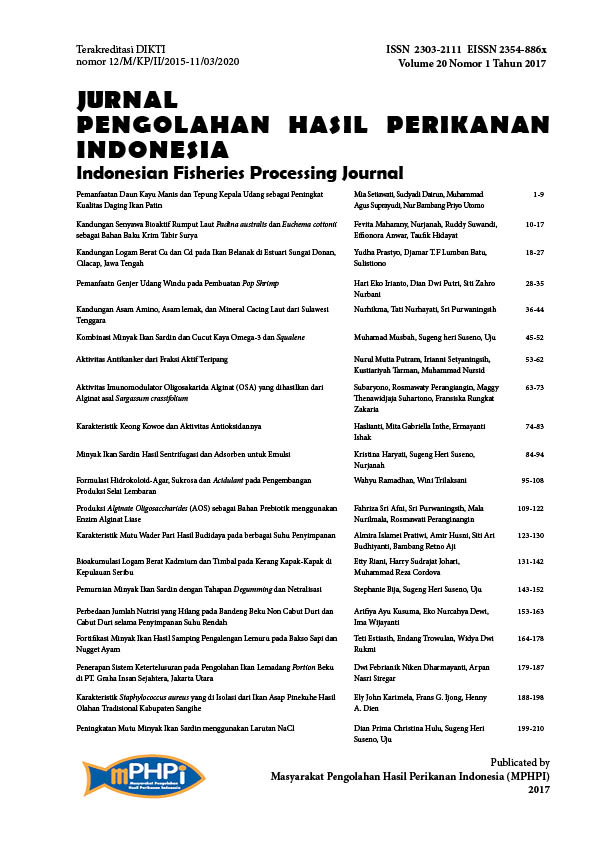Purification of Sardine Fish Oil Through Degumming and Neutralization
Abstract
The quality of sardine fish oil can be improved by purification method through the step of degumming and neutralization. The aimed of this this study was analysis characteristic of crude sardin fish oil and determined the best method of purification. Degumming was carried out using 30% water and salt at concentration 5%, 8%, 10% b/v. Neutralization process using NaOH with 16°Be and bleaching using 5% Magnesol XL. All step of refining was done at 50°C, 60°C, 70°C, and 80°C. The result of analysis showed that sardine crude fish oil had 24.86% of palmitic acid as the highest fatty acid, heavy metal was not detected,
dencity was 0.92 g/cm3 and viscocity was 51 cPs. The best treatment of purification method was degumming using 5% NaCl at 50°C with rendement 65.37±0.72%; free fatty acid (FFA) 0.38±0.03%; peroxide (PV) 1.07±0.12 mEq/kg; anisidine (p-AnV) 15.18±0.16 mEq/kg; total oxidation value (TOTOX) 17.31±0.39 mEq/kg; and clarity was 75.09± 1.20%.
dencity was 0.92 g/cm3 and viscocity was 51 cPs. The best treatment of purification method was degumming using 5% NaCl at 50°C with rendement 65.37±0.72%; free fatty acid (FFA) 0.38±0.03%; peroxide (PV) 1.07±0.12 mEq/kg; anisidine (p-AnV) 15.18±0.16 mEq/kg; total oxidation value (TOTOX) 17.31±0.39 mEq/kg; and clarity was 75.09± 1.20%.
Authors
BijaS., SusenoS. H., & UjuU. (2017). Purification of Sardine Fish Oil Through Degumming and Neutralization. Jurnal Pengolahan Hasil Perikanan Indonesia, 20(1), 143-152. https://doi.org/10.17844/jphpi.v20i1.16501
Authors who publish with this journal agree to the following terms:
- Authors retain copyright and grant the journal right of first publication with the work simultaneously licensed under a Creative Commons Attribution License that allows others to share the work with an acknowledgement of the work's authorship and initial publication in this journal.
- Authors are able to enter into separate, additional contractual arrangements for the non-exclusive distribution of the journal's published version of the work (e.g., post it to an institutional repository or publish it in a book), with an acknowledgement of its initial publication in this journal.





